
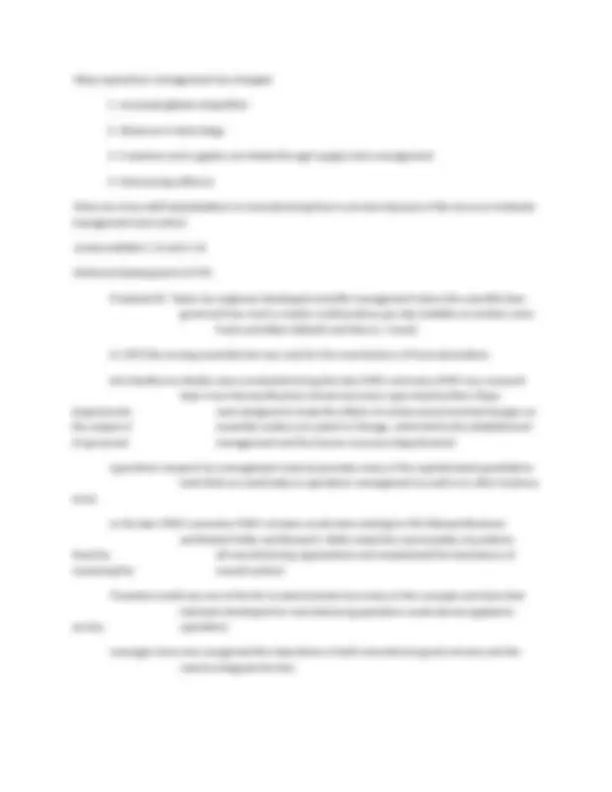
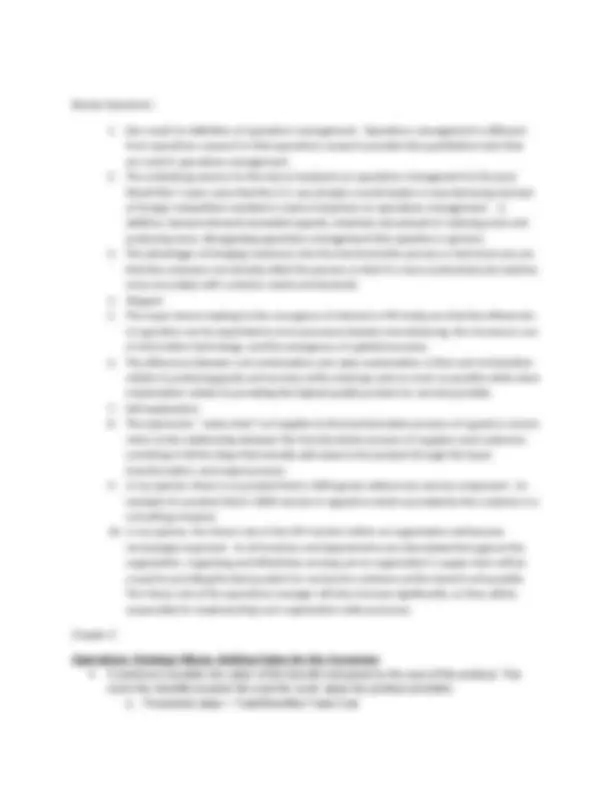
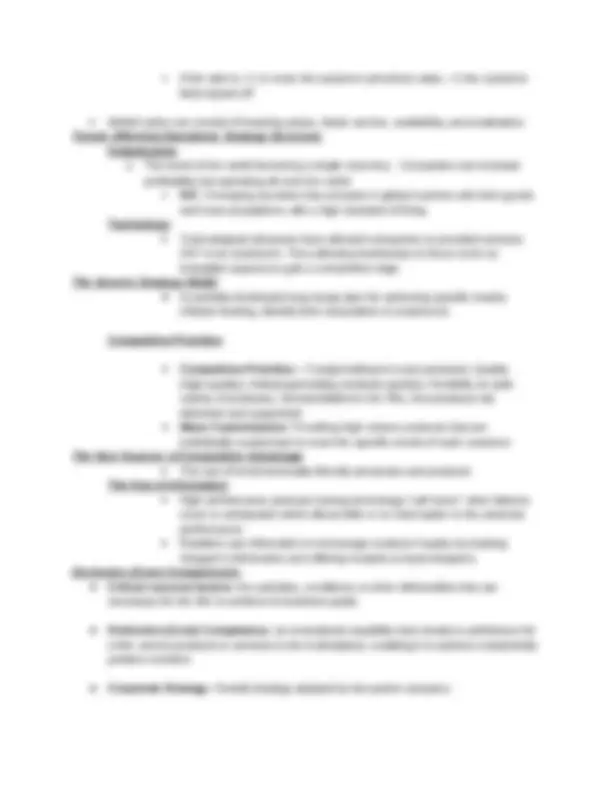
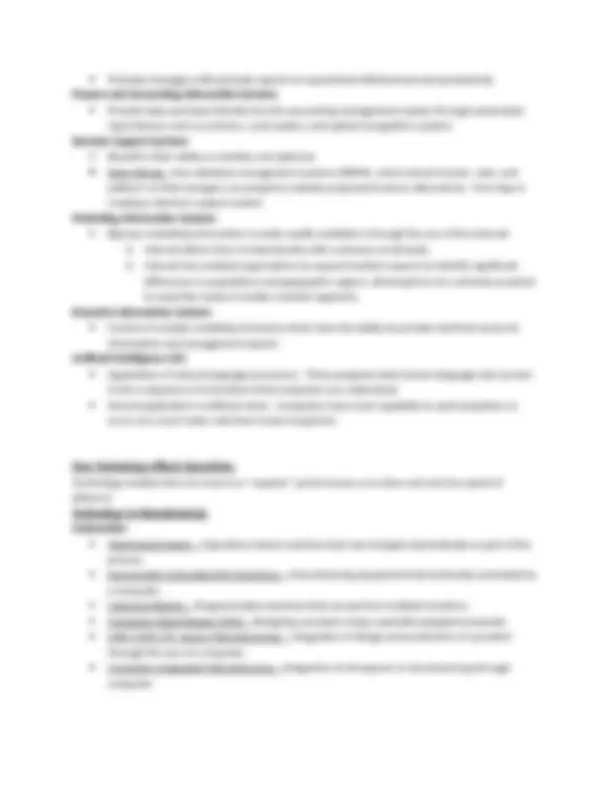
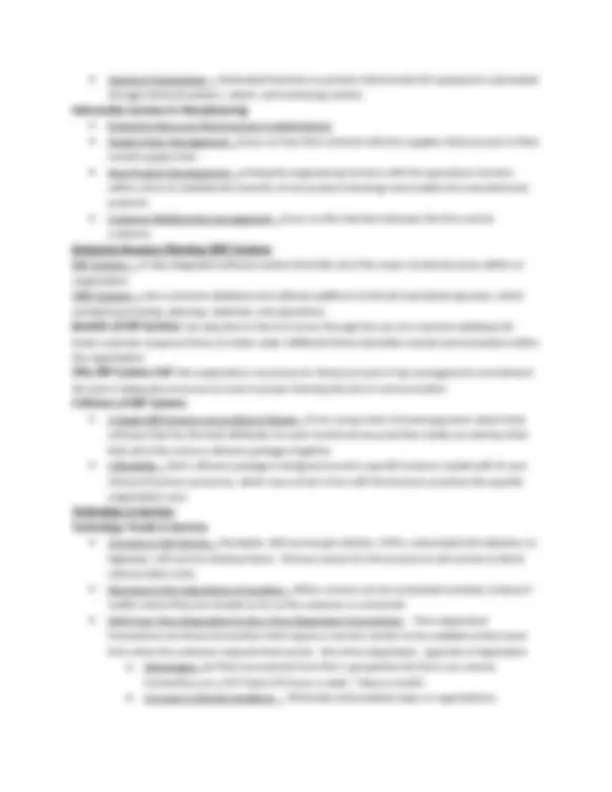
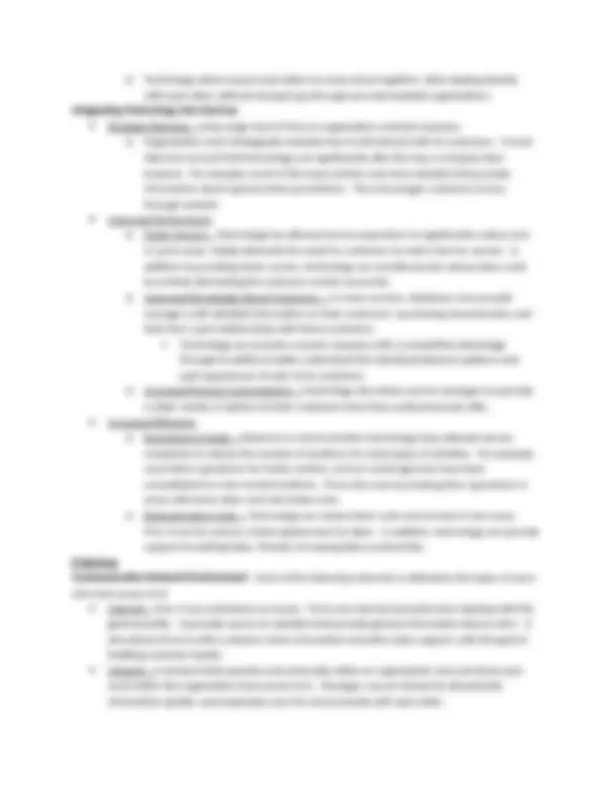
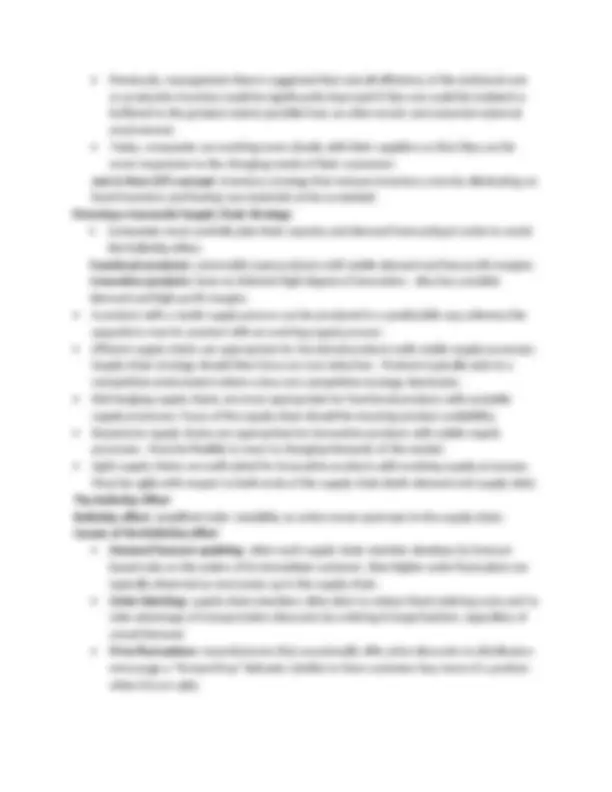
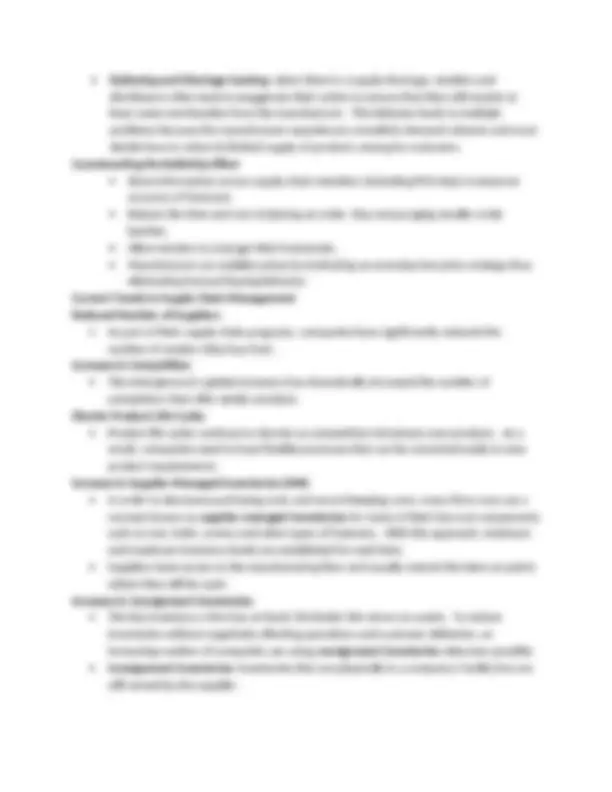
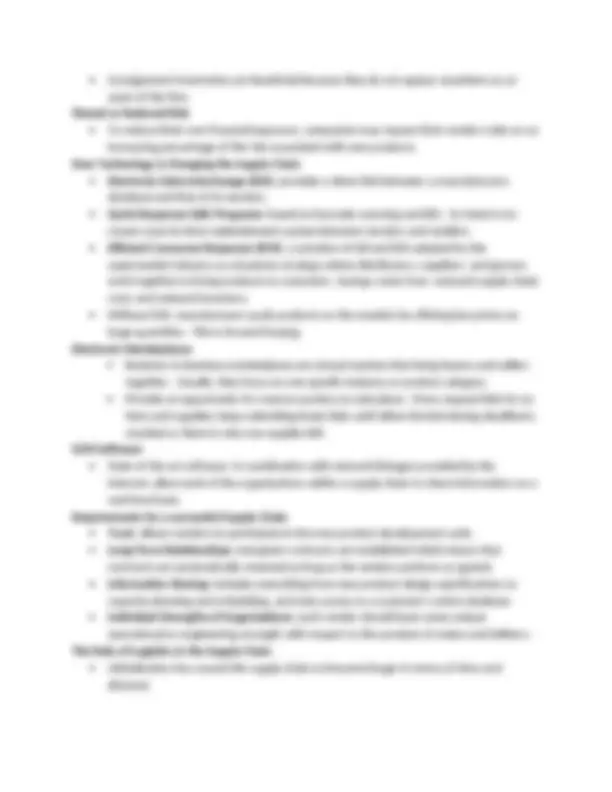
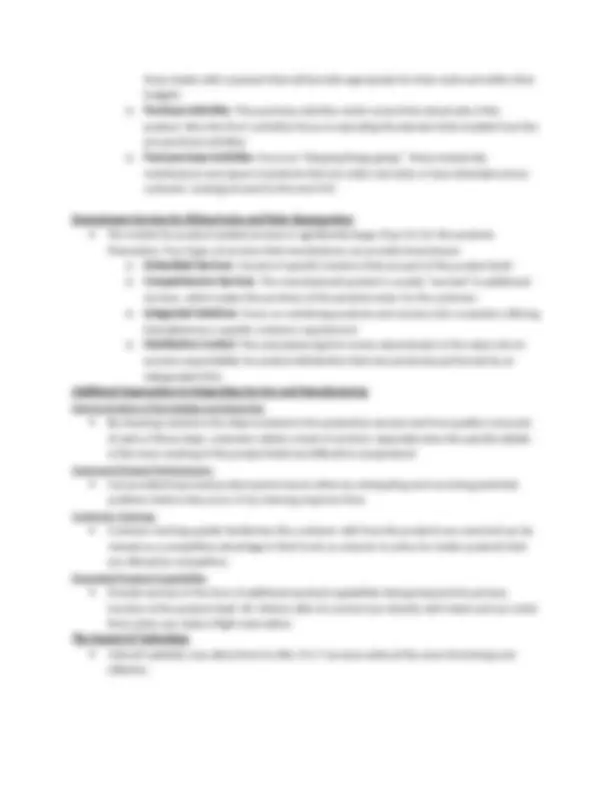
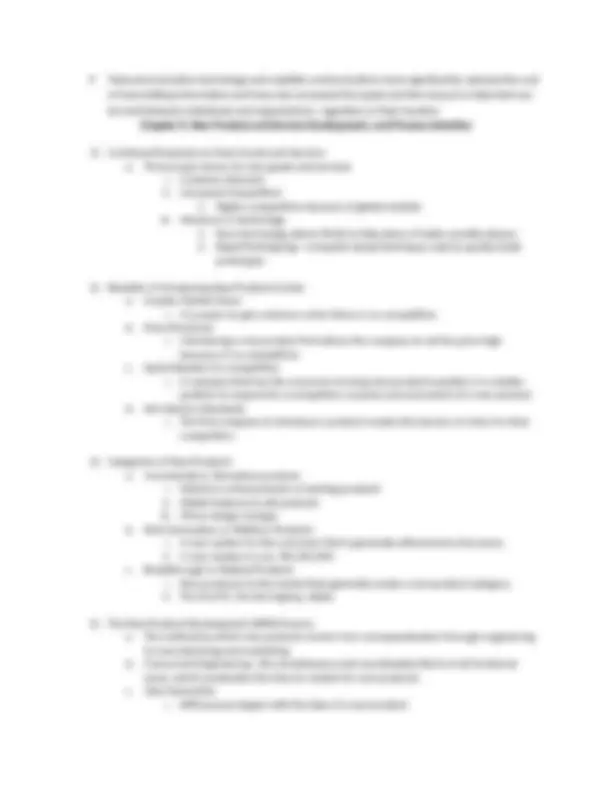
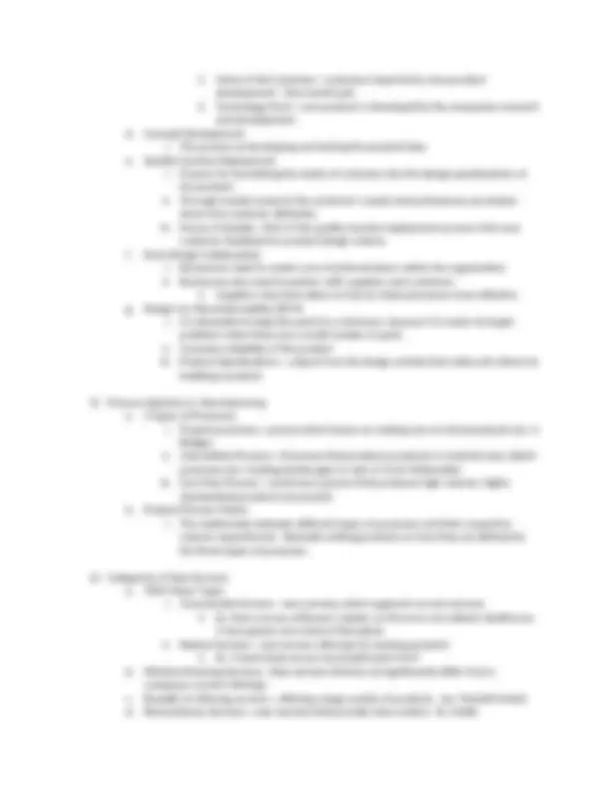
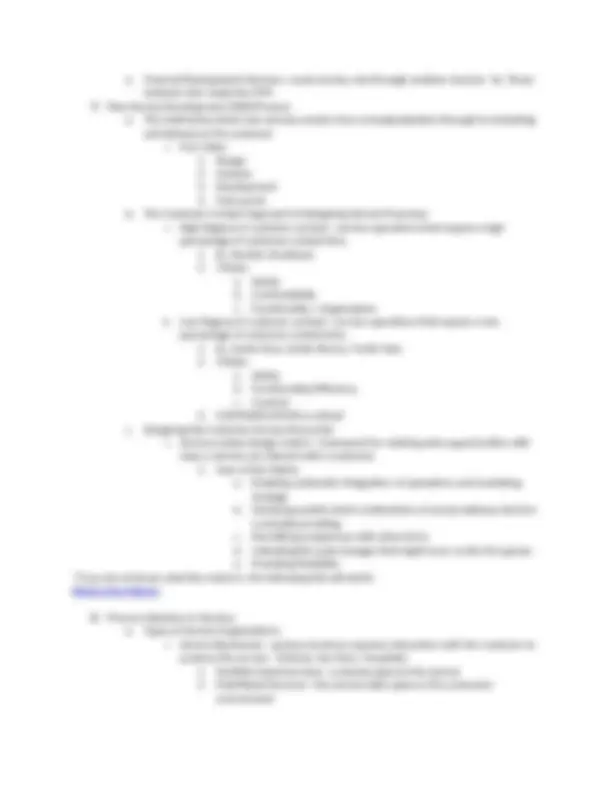



Study with the several resources on Docsity

Earn points by helping other students or get them with a premium plan


Prepare for your exams
Study with the several resources on Docsity

Earn points to download
Earn points by helping other students or get them with a premium plan
Community
Ask the community for help and clear up your study doubts
Discover the best universities in your country according to Docsity users
Free resources
Download our free guides on studying techniques, anxiety management strategies, and thesis advice from Docsity tutors
Material Type: Notes; Professor: Jefferson; Class: Operations Management; Subject: Management; University: Bryant University; Term: Fall 2009;
Typology: Study notes
1 / 22

This page cannot be seen from the preview
Don't miss anything!















Vocab: Operations Management: management of the conversion process that transforms inputs such as raw material and components into outputs in the form of finished goods and services Transformation Process: actual conversion of inputs into outputs (sometimes referred to as the technical core) Global Economy, Global Village, Global Landscape: terms used to describe how the world is becoming smaller and countries are becoming more dependent on each other Value Chain: steps an organization requires to provide a good or a service, regardless of where they are performed Virtual Enterprise: company whose boundaries are not clearly defined due to the integration of customers and suppliers (interdependency) Scientific Management: systematic approach to increasing worker productivity introduced by Frederick W. Taylor
Notes: -management decisions can be divided into three broad areas within the operations function:
-Operations management’s contributions to society:
Review Questions:
If the ratio is >1 or more the customer perceives value, <1 the customer feels ripped off
Trends Affecting Operations Strategy Decisions^ ^ Added value can consist of lowering prices, faster service, availability, personalization Globalization o The trend of the world becoming a single economy. Companies can increase profitability but operating all over the world. NIC - Emerging countries that compete in global markets with their goods Technology^ and have populations with a high standard of living Technological advances have allowed companies to provided services 24/7 to its customers. Thus allowing businesses to focus more on
The Generic Strategy Model^ intangible aspects to gain a competitive edge A carefully developed long-range plan for achieving specific results. (Obtain funding, identify their competitors & customers) Competitive Priorities Competitive Priorities – Cost(providing low cost products), Quality (high-quality), Delivery(providing products quickly), Flexibility (a wide variety of products), Service(Added in the ‘90s, how products are delivered and supported) Mass Customization - Providing high volume products that are The Next Sources of Competitive Advantage^ individually customized to meet the specific needs of each customer The Use of Information^ ^ The use of environmentally friendly processes and products High performance products having technology “call home” when failures occur or anticipated which allows little or no interruption in the products performance.Retailers use information to encourage customer loyalty by tracking Distinctive (Core) Competencies^ shopper’s information and offering rewards to loyal shoppers. Critical success factors- necessary for the firm to achieve its business goals. the activities, conditions or other deliverables that are Distinctive (Core) Competency- an exceptional capability that creates a preference for a firm and its products or services in the marketplace, enabling it to achieve a leadership position overtime Corporate Strategy- Overall strategy adopted by the parent company
o The skill qualifications, schedules, training and evaluating of its workers Quality Management o Managers also need to decide how quality will be defined, measured and monitored within their organizations Policies & Procedures o Managers need to define how the work will be performed and how decisions will be made. They can make a huge difference in the quality and efficiency of the manufacturing and service processes. Organizational structure o The hierarchical structure of an organization defines who reports to whom, which in turn determines how the work gets done Operations Strategy and Trade-Offs^ LOOK AT EXHBIT 2. A factory could not simultaneously excel on all four competitive priorities. Management had to decide which priorities were critical to the firm’s success and Questioning the Trade-Offs^ then focus on those characteristics. o Managers realized that they didn’t have to make the trade-offs that they previously thought. They needed to establish a hierarchy among the different Order-Qualifiers and Order Winners^ priorities (EXHIBIT 2.3) o Order-Qualifiers- minimum characteristics of a firm or its products to be considered as a source of purchase o Order-winners- Characteristics of a firm that distinguish it from its competition so that it is selected as the source of purchase Contemporary Issues in Operations Strategy Focusing on Core Capabilities o Core capabilities- Specific strengths that allow a company to achieve its competitive priorities Integrating Manufacturing and Services o Firms are now looking to integrated and user-friendly service as a means to obtaining a competitive advantage
Types of Computer Information Systems: Management Information Systems
Provides managers with periodic reports on operational effectiveness and productivity Finance and Accounting Information Systems Provide sales and input directly into the accounting management system through automated input devices such as scanners, card readers, and optical recognition systems. Decision Support Systems Benefit is their ability so satisfice and optimize. Data Mining - Uses database management systems (DBMS), which extract trends, rules, and patterns so that managers can properly evaluate proposed business alternatives. First step in creating a decision support system Marketing Information Systems Big way marketing information is made readily available is through the use of the internet. o Internet allows firms to deal directly with customers at all levels. o Internet has enabled organizations to expand market research to identify significant differences in populations and geographic regions, allowing firms to customize products to meet the needs of smaller markets segments. Executive Information Systems Consist of complex modeling structures which have the ability to provide real-time access to information and management reports. Artificial Intelligence (AI) Application of natural language processors. These programs take human language and convert it into a sequence of instructions that computers can understand. Second application is artificial vision. Computers have more capability to spot exceptions or errors at a much faster rate than human inspection.
How Technology Affects Operations Technology enables firms to move to a “superior” performance curve (low cost and low speed of delivery) Technology in Manufacturing Automation Machining Centers – Operations where machine tools are changed automatically as part of the process. Numerically Controlled (NC) Machines – Manufacturing equipment that id directly controlled by a computer. Industrial Robots – Programmable machines that can perform multiple functions. Computer Aided Design (CAD) – Designing a product using a specially equipped computer. CAD/ CAM (‘M’ means Manufacturing) – Integration of design and production of a product through the use of a computer. Computer-Integrated Manufacturing – Integration of all aspects of manufacturing through computer.
o Technology allows buyers and sellers to come closer together, often dealing directly with each other without having to go through any intermediate organizations. Integrating Technology into Services Strategic Planning – Long range view of how an organization conducts business. o Organization must strategically evaluate how it will interact with its customers. It must take into account that technology can significantly alter the way a company does business. For example, most of the major airlines now have websites that provide information about special airfare promotions. This encourages customers to buy through website. Improved Performance o Faster Service – Technology has allowed service operations to significantly reduce and, in some cases, totally eliminate the need for customers to wait in line for service. In addition to providing faster service, technology can simultaneously reduce labor costs by entirely eliminating the customer-worker encounter. o Improved Knowledge About Customers – In many services, databases now provide managers with detailed information on their customers’ purchasing characteristics and their firm’s past relationships with these customers. Technology can provide a service company with a competitive advantage through its ability to better understand the individual behavior patterns and past experiences of each of its customers. o Increased Product Customization – Technology also allows service managers to provide a wider variety of options to their customers than they could previously offer. Increased Efficiency o Economies of Scale – Advances in communication technology have allowed service companies to reduce the number of locations for many types of activities. For example, reservation operations for hotels, airlines, and car rental agencies have been consolidated to a few central locations. Firms also save by locating their operations in areas with lower labor and real estate costs. o Reduced Labor Costs – Technology can reduce labor costs and services in two ways. First, it can be used as a total replacement for labor. In addition, technology can provide support to existing labor, thereby increasing labor productivity. E-Services Communication Network Environment – Each of the following networks is defined by the types of users who have access to it Internet – Few, if any restrictions on access. Firms use internet primarily when dealing with the general public. It provides access to websites that provide general information about a firm. It also allows firms to offer customer richer information and after-sales support, with the goal of building customer loyalty. Intranet – A network that operates only internally within an organization and only those who work within the organization have access to it. Managers use an intranet to disseminate information quickly, and employees use it to communicate with each other.
Extranet – Allows specific external sources to have limited access to a firm. Organizations use an extranet to share classified or highly sensitive data with their business partners. Electronic Data Interchange – The electronic exchange of data in highly specified formats that takes place typically between organizations. o Consequences: (a) Delay between when the data is sent/received (b) expensive to add a value-added network in which EDI transactions take place o Because of these consequences, the extranet will most likely replace EDI in the future as a medium of communication Types of E-Services E-tailers – Firms that provide goods and services through the Internet and conduct their business exclusively through the Internet. o Challenges: (a) Difficult to have the necessary infrastructure to efficiently and quickly deliver the goods to its customers (b) Lack of tangibility (c) Difficult to differentiate themselves in the marketplace Customer Support – Major challenge is: Support services need to persuade customers to switch from requesting customer support through call centers, which are time-dependent and involve interacting with an actual person, to Internet activities, which are non-time-dependent and are therefore more efficient. Network Providers – E-services that provide a connected network for buyers and sellers to exchange goods and services. o Advantages: Buyers spend less time to obtain quotes from a number of vendors, resulting in significant savings. Sellers can operate without a distributor or salesperson, reducing costs. Eliminates intermediaries. Information Providers – o Infomediary – E-service business that primarily focuses on providing information. Application Service Providers (ASPs) – Firms that provide remote services to customers. For example, an ASP accounting firm will have on its own server the most current accounting software package that reflects the latest changes in the tax laws. With an accounting ASP, customers no longer need to buy a new software package every time the tax laws change. o Challenge: To convince customers that they are not fly-by-night operations and will be in business for the long term. Along with demonstrating financial strength to survive in the long term, ASPs also must convince customers that they provide highly reliable services and that they are trustworthy with sensitive customer data that are given to them. Finally, customers must have confidence in the reliability of the network they use to connect to their ASPs. Technology-Related Issues Overcoming Barriers to Entry Mangers need to be aware that, as new technologies become available, there are often barriers that prevent customers from using them. o Ex: First time one purchases goods over Internet. Credit card misuse?
Managerial Issues Bundle of Benefits The overall product offering that includes goods and services. Order qualifier Minimum characteristics of a firm or its products to be considered as a source of purchase. Order Winners Characteristics of a firm or its products that distinguish it from its competition so that it is selected as the source of the purchase.
The Increasing Role of Service in Manufacturing The growing battle for customers can be attributed, in large part, to the significant increase in international competition over that past several decades. To maintain and even increase profit margins, many manufacturing firms now focus on services to obtain a competitive advantage in the market place. This increase emphasis on services can be attributed to the advances in information technology, the explosive development and growth of the internet.
Added services create a win-win situation. The service adds value, thereby creating a competitive advantage for the firms in the customer’s eye. While Profit margin for the service is very often significantly greater than the cost to provide the service. Defining Levels of Added Service: Little “s” and Big “S” Little “s,” or Operational, Services Are provided primarily within the operations function of an organization. These types of services are usually applied to existing products to make them more attractive to customers. Made up of two categories o Availability - Which is time and location. Also 24 x 7 services. o Customization - Modifying the standard product offering to meet the needs of each individual customer. The manufacturing process must be sufficiently flexible to accommodate a wide variety of individual customer specifications.
Big “S,” or Strategic, Services Those services that require coordination across organizational boundaries. These embedded services typically require coordination among the engineering, manufacturing, and customer support functions. Three frameworks which explain how service can be successfully integrated with manufacturing. Service factory, Customers activity cycle, and downstream services. The Service Factory by Dick Chase and David Garvin A manufacturing facility that can also provide services to a firm’s customers. Three main roals: o Consultant - A manufacturing firm can utilize the expertise of its factory workers to address customer-related issues, especially with respect to problem solving. o Showroom - the factory floor can be used to demonstrate to customers the technical expertise and the quality of the processes that are used to manufacture goods or components. Three necessary factors needed: Marketing and manufacturing personnel need to work closely together to understand customer’s expectations and ten to fulfill these expectations. Factory workers and their supervisors must be trained to communicate with customers and even to make formal presentations to them. The layout of the factory floor must permit stopping points for visitors and perhaps even audiovisual aids to emphasize those aspects of the production process that provide the greatest value added for the customers. o Dispatcher - The factory can provide the link to after-sales service support. A firms ability to quickly repair or replace defective equipment can be a competitive advantage. Customers Activity Cycle by Sandra Vandermerwe All of a customer’s activities related to the purchase of a product. The larger the portion of the CAC that a firm participates in by providing related services, the greater the competitive advantage that firm has in the marketplace. Three major components of the CAC: Pre-purchase activities, Purchase activities, and Post-purchase activities. o Pre-purchase - The firm should listen to their customers descriptions of how they thing they will use the product and how much they can afford to send and help them to match
Telecommunication technology and satellite communications have significantly reduced the cost of transmitting information and have also increased the speed and the amount of data that can be sent between individuals and organizations, regardless of their location Chapter 6: New Product and Service Development, and Process Selection
ii.^ i.^ Customer DemandIncreased Competition iii. Advances in technology^ 1.^ Higher competition because of global markets
b. Price Premiums^ i.^ It is easier to get customers when there is no competition i. Introducing a new product first allows the company to set the price high because of no competition. c. Quick Reaction to competition i. A company that has the resources to bring new products quickly is in a better d. Set Industry Standards^ position to respond to a competitors surprise announcement of a new product i. The first company to introduce a product creates the barriers of entry for their competitors.
ii.^ i.^ Hybrid or enhancements of existing productsAdded features to old products b. Next Generation or Platform Products^ iii.^ Minor design changes ii.^ i.^ A new system for the consumer that is generally offered every few years.A new model of a car; PS1,PS2,PS c. Breakthrough or Radical Products i. New products to the market that generally create a new product category ii. The first PC; the first laptop; dildos
b. to manufacturing and marketingConcurrent Engineering—the simultaneous and coordinated efforts of all functional c. areas, which accelerates the time to market for new products.Idea Generation i. NPD process begins with the idea of a new product
Process Selection in Manufacturing a. 3 Types of Processes i. Project processes—process that focuses on making one of a kind products (ex. A Bridge) ii. Intermittent Process—Processes that produces products in small lot sizes, Batch processes (ex. Cooking hamburgers in sets of 12 at McDonalds) iii. Line Flow Process—continuous process that produces high-volume, highly standardized products (ex pencils) b. Product Process Matrix i. The relationship between different types of processes and their respective volume requirements. Basically ranking products on how they are defined by the three types of processes.
Categories of New Services a. TWO Major Types i. Incremental Services—new services which augment current services 1. Ex. New courses at Bryant; Lobster on the menu at outback steakhouse. ii. Radical Services—new service offerings for existing products^ (I have grown very fond of that place) b. Window Dressing Services—New services that do not significantly differ from a^ 1.^ Ex. A bank kiosk at your local pathmark/A & P c. companys current offeringsBreadth-of-offering services—offering a large variety of products. (ex. Mariott hotels) d. Revolutionary Services—new services that provide new content. Ex. FedEx